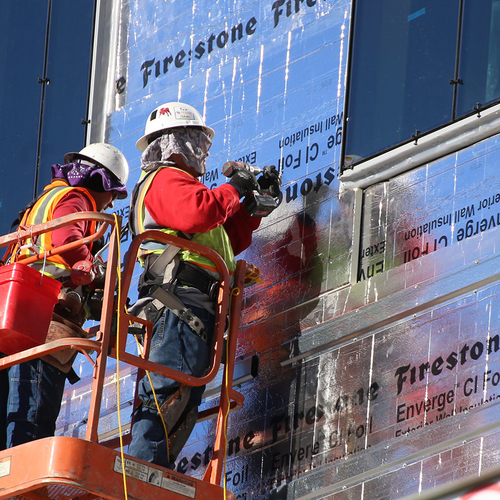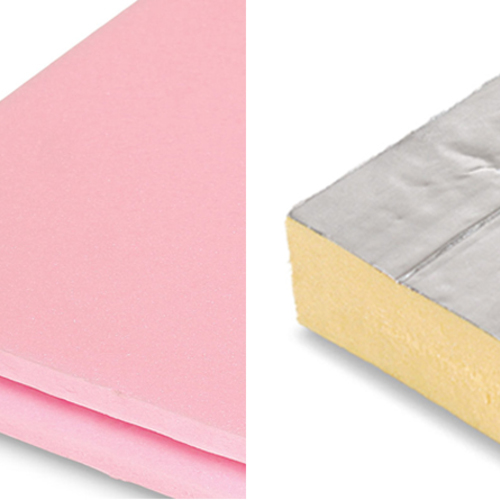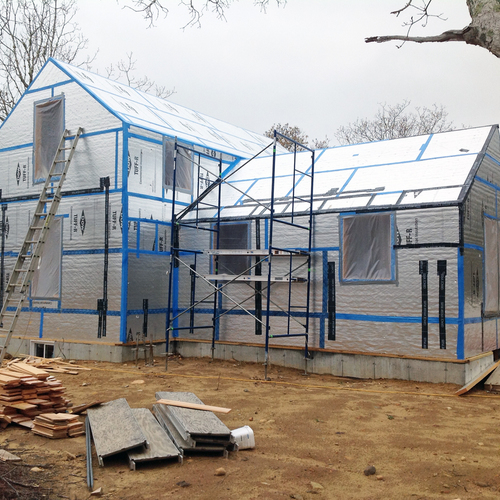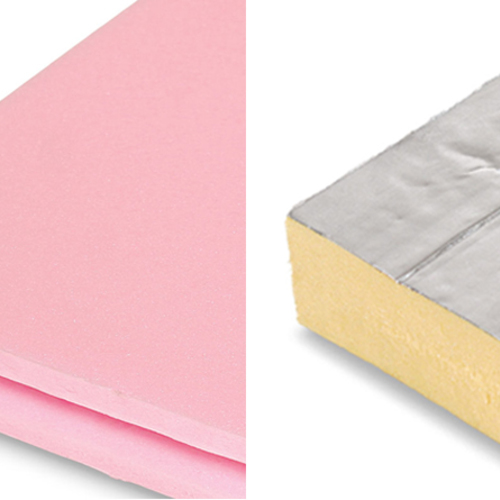
Image Credit: Fine Homebuilding
We’ve all seen tables that list the R-value per inch for a variety of insulation types. These tables are handy, of course, but because old information is endlessly republished, in some cases long after the old information becomes obsolete, the tables are often flawed. Most authors make little effort to update these tables in light of the latest information from researchers.
Many authors, including me, have reported that polyisocyanurate has an R-value of R-7 per inch. That information is both obsolete and misleading — a lower value is more accurate — yet it still shows up in many online tables and articles.
In some cases, older R-value tables have values that are misleadingly low. For example, in the old days, most fiberglass batts had relatively low R-values — in the range of R-3.2 to R-3.4 per inch. But insulation manufacturers now offer high-density fiberglass batts with R-values of R-3.7 per inch or more.
The information in the table below reflects recent manufacturing changes and researchers’ findings, making it more up-to-date than information in some online tables. Moreover, the table includes information that is often lacking from R-value tables, including information on cold-weather performance and thermal drift.
A few general principles and hints
Where can I find brand-specific R-value information? In the U.S., insulation manufacturers are required by law to report the R-values of their products to builders and homeowners. Acceptable laboratory test methods for determining R-value, and requirements for R-value labeling, are specified by a federal law (16 CFR 460) called the R-value Rule. Because of this law, most major insulation manufacturers publish trustworthy R-value information.
If you want to know the R-value of a specific product, the information is usually available with a simple web search. (For example, this useful document reports the R-values of all of…
Weekly Newsletter
Get building science and energy efficiency advice, plus special offers, in your inbox.

This article is only available to GBA Prime Members
Sign up for a free trial and get instant access to this article as well as GBA’s complete library of premium articles and construction details.
Start Free TrialAlready a member? Log in















19 Comments
BIBS - blown-in-blanket fiberglass
Does the blown in fiberglass row in the table refer to the product marketed as BIBS (blown in blanket system)? The purveyors of that system claim 4.2 per inch.
Response to Reid Baldwin
Reid,
The R-value information for blown-in fiberglass in the table refers to loose-fill insulation on an attic floor.
Your point is a good one: BIBS insulation (usually installed behind netting in walls) has a higher R-value per inch; values of R-4.1 or even R-4.2 are often provided for BIBS.
Thanks for your comment.
Second response to Reid Baldwin
Reid,
I have updated the table to include information on BIBS. Again, thanks.
ccSPF in 40 years
Thanks for collecting this all in one place. One that I'm wondering about is the long term performance of closed-cell spray foam. I would have thought that would be similar to polyiso. I haven't researched it thoroughly, but this reference seems to indicate a similar final value.
http://www.dtic.mil/docs/citations/ADA618149
Response to Charlie Sullivan
Charlie,
I agree. Thanks for catching the error. I have updated the table.
Blown in fiberglass and convective looping at cold temps
I thought it was established that loose-fill (attic) fiberglass experienced significant convective loop heat loss at colder temperatures.
See:
http://docserver.nrca.net/technical/401.pdf
https://www.greenbuildingadvisor.com/community/forum/energy-efficiency-and-durability/39913/convective-looping-fiberglass-batts
Unless there's new information on this, I would have thought that its cold temperature performance would be rated 'worse' rather than 'better'.
Response to Douglas Horgan
Douglas,
Here's Chris Schumacher, the engineer in charge of the Building Science Corporation's Thermal Metric Project, describing what happens to the performance of fiberglass batts at cold temperatures: “If you measure the R-value of an R-13 fiberglass batt, you’ll get different results at different outdoor temperatures. If the outdoor temperature rises, the R-value goes down. If the outdoor temperature drops, the R-value rises. Why? Because as you move to a higher temperature, you get more radiation happening, and therefore a lower R-value. But at lower temperatures, there is less conduction, less convection, and less radiation — and therefore a higher R-value."
Manufacturers of loose-fill fiberglass have changed the manufacturing process to create fibers that reduce opportunities for convective looping. Moreover, denser batts reduce convection compared to low-density batts. Most insulation experts agree with Schumacher: at cold temperatures, the positive effects due to the reduction in conduction and radiation -- and believe it or not, convection -- outweigh the negative effects of convective looping.
That said, this is a complicated issue, and certain installations of fiberglass may still have convective looping problems. To some extent, that this type of looping is exacerbated by air leaks through the thermal envelope; the negative effects of air leakage need to be separated from the effects that lower temperatures have on R-values.
T vs. dT for fiberglass
The scenario that leads to convective looping with fiberglass is a large temperature difference between the bottom and top of the fiberglass, with the top open to the attic. The effects that are described above by Martin quoting Chris Schumacher are the effects of the temperature in the fiberglass, not the temperature difference across it.
Often those two go together. If you have loose fill insulation in the attic, when the outdoor temperature gets cold, you have a big delta-T across the fiberglass, and the average temperature in the attic insulation is lower. But there are cases in which you might want to compare performance of fiberglass at different temperatures but with the same delta-T. For example, suppose you were comparing two attic insulation systems. One has a conditioned attic with fiberglass between the rafters below the deck and polyiso above the deck. The other has a vented attic insulated at the attic floor with polyiso below the joists, covered by the fiberglass above the joists. The second would perform better than the first in cold weather, because the fiberglass would be cold, which improves its r-value, and the polyiso would be warm, which improves its r-value. And neither would have a particularly big delta-T across it, so the convective looping wouldn't be a major issue.
So I would use Martin's chart as follows: I'd use the temperature performance column to understand how the performance of the insulation varies vs. its position in the assembly, for a cold climate. For the concern about convective looping, I'd regard anything listed as "poor" with regard to reducing air leakage as potentially subject to convective looping, and would consider its performance in an open-top attic application somewhat lower than listed, unless it's capped by a denser insulation, such as 3" of cellulose blown over the top.
Response to Charlie Sullivan
Thanks, Charlie. Your comments are helpful.
Polyisocyanurate
What's the perm rate of felt faced poly iso (commonly used on commercial roofs)? Or what's the rating of just the polyisocyanurate?
Depends @(Buzz Burger)
Asphalted felt facers on polyiso are typical rated as < 1 perm, with no lower bound given. Unfaced 2 lb density polyiso typically runs between 2.5- 5 perms @ 1".
eg: This unfaced product is 4 perms @ 1":
http://www.itwinsulation.com/trymer/library/data_sheets/itw_trymer_2000_xp.pdf
At higher density the permeance is usually lower.
Mineral Wool Exterior Insulation Performance
Has anyone seen detailed reports on the performance of mineral wool boards (like Roxul ComfortBoard 80 or 110) placed between sheathing (Zip or other air and water barrier) and a vented rain screen. Since the mineral wool is air and vapor permeable, are there mechanisms that degrade its thermal performance relative to rigid foam in this application?
Response to Buzz Burger
Buzz,
I agree with Dana Dorsett -- "it depends."
One source says that 1 inch of polyiso without any facing has a permeance of 26 perms.
Polyiso with a "glass-coated mat" facing or a felted paper facing is usually in the range of 1 to 10 perms. (Source: http://www.atlasroofing.com/continuous-wall-insulation/faq)
density matters
1lb polyiso without facers might run as high as 26 perms @ 1" but most of roofing polyiso sold is 2lb density (some are higher) , and typically sold in thickness greater than 1".
Paper facers that are NOT asphalt loaded or otherwise treated can be very permeable, and the vapor permeance of the product is determined by the polyiso itself (thickness & density). But many (most?) paper facers on polyiso are treated with asphalt or other materials to bring the final product under 1 perm independent of thickness or density. eg:
http://www.carlislesyntec.com/download.aspx?fileID=6363
Response to Pat Kiernan (Comment #12)
Pat,
It sounds as if you are wondering whether the performance of semi-rigid mineral wool is degraded by wind-washing. Anecdotally, I've heard that the consensus is, "Don't worry about it." Obviously, the denser the insulation, the less you have to worry about wind-washing.
Here is a link to a previous Q&A thread on the topic: Mineral Wool Exterior Insulation, Humidity and Windwashing.
More on mineral wool and wind-washing
Pat,
I found the quote I was looking for. According to building scientist John Straube, “I wouldn’t put the housewrap on top of the Roxul — I would put it behind the Roxul. For one thing, installing the housewrap between the Roxul and the furring strips would be a pain. Anyway, one of the reasons for choosing high-density rockwool is that it is dense enough to resist wind-washing.”
The quote came from an interview I conducted with John Straube in 2011. Here is a link to the relevant article: Installing Mineral Wool Insulation Over Exterior Wall Sheathing.
RE: More on mineral wool and wind-washing
Martin,
Thanks! That's exactly what I was looking for.
Thanks.
Thanks Dana and Martin, that's helpful. I'm in southeastern Pennsylvania and we have periods of fairly hot and humid weather, but typically not for extended periods. Similarly in winter, we sometimes have very cold spells, but not for extended periods. What we typically have for extended periods is shoulder season weather where the cooling or heating loads are very low. I think this makes optimizing for vapor drive control tricky. I have concluded that the best wall in this situation would consist of a WRB at the exterior sheathing level with cellulose in the interior cavity and rigid foam or Roxul on the exterior with approximately the same R value on either side and a 3/4" ventilation gap behind the cladding. I would then endeavor to keep both sides as vapor open as possible to maximize drying potential in either direction. I said that this was what I have concluded but I am not totally confident that I am right or that I am not missing something important since I can't help but notice that it is not often done that way. Polyiso by itself is relatively permeable but whether it's for roofs or sidewalls it is almost always made with at least some sort of vapor retarding facing and on the insulation comparison chart above, only foil faced is listed. If installing Roxul on the exterior is acceptable, why wouldn't a truly vapor open rigid foam be acceptable? Is the facing there to protect the polyiso which does have a tendency to absorb moisture? If so, could a house wrap provide that protection? If cost were no object, I would use mineral wool. But it is more and the felt faced and paper faced versions are significantly less expensive than foil faced.
Response to Buzz Burger
Buzz,
If you decide to go with a continuous layer of rigid foam on the exterior side of your wall sheathing, the rigid foam doesn't need to be vapor-permeable. It just has to be thick enough to keep the plywood or OSB wall sheathing above the dew point during the winter.
Everything on the exterior side of the rigid foam (the furring strips and the siding) dries to the exterior.
Everything on the interior side of the rigid foam (the sheathing, studs, and fluffy insulation) dries to the interior.
So don't worry about the vapor permeance of the rigid foam.
For more information on this topic, see How to Design a Wall.
Log in or become a member to post a comment.
Sign up Log in